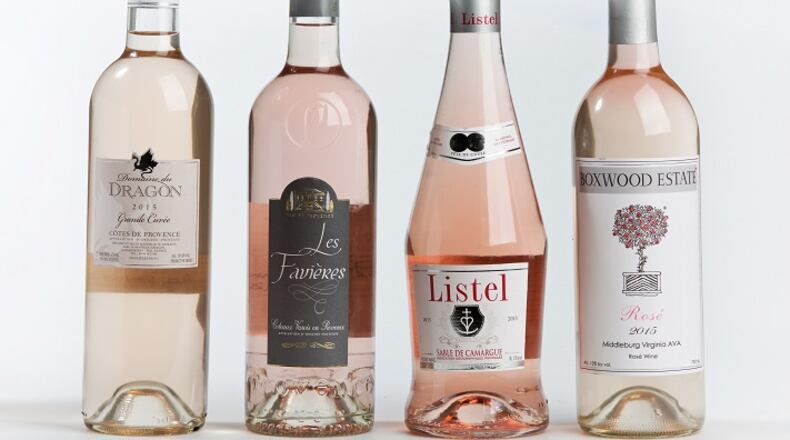“Spring is sprung, the grass is riz, I wonder where the flowers is.”
The hoary old saying is attributed to everyone from Ogden Nash to Al Capone.
In any case, it nicely expresses the exuberance of the season, as temperatures rise and we put away the heavy wines of winter.
To me, the wine of spring is rosé. It’s light and lively, filled with the perfume of flowers, just the thing for picnics and patio parties.
Positioned between red and white wines, rosés go with an huge variety of casual, uncomplicated dishes — ham, turkey, chicken, salmon, cold cuts of all kinds, sandwiches of chicken, ham, turkey, tuna or egg salad, Asian stir-fry, spicy seafood stews.
Rosé wines can be served over a range of temperatures. I like this method: Put it in the fridge overnight. Open and serve it chilled, then leave it on the table during the meal and note how the aromas and flavors change as it warms.
The infinite variety of rosés stems from their many grapes. There’s hardly a red grape that hasn’t been made into a rosé — from sweet and fruity grenache to lush pinot noir, syrah, tempranillo, pinot nero, and, surprisingly even muscular cabernet sauvignon and petite sirah.
Nearly every wine region makes a rosé wine from its signature grape. There are tasting notes here for rosés made in California, Washington state, Spain, Italy, France and Argentina.
Rosé wines can be made in several ways, since even the reddest of grapes has white juice inside. In the maceration method, red grapes are crushed and the white juice is left on the red skins just long enough – maybe a day or two — to pick up a little color.
In the saignée method, red grapes are crushed and the juice is left on the skins for a short time, and then part of it is bled off as rosé, with the rest of the juice left on the skins long enough to become red wine.
Finally, the easiest method, winemakers make red wine from red grapes and white wine from white grapes, then blend the two in the right proportion to make rosé wine.
HIGHLY RECOMMENDED
— 2015 Stoller Family Estate Pinot Noir Rosé, Dundee Hills, Ore.: aromas of roses and camellias, flavors of pink grapefruit, light and crisp; $25.
— 2015 Quivira Vineyards Rosé, Dry Creek Valley, Sonoma County, Calif. (55 percent grenache, 20 percent mourvèdre, 10 percent syrah, 10 percent counoise, 5 percent petite sirah): red-berry aromas, flavors of white grapefruit and honey, light and crisp; $22.
— 2015 Pascal Jolivet Sancerre Rosé, Loire Valley, France (100 percent pinot noir): pale salmon hue, floral aromas, crisp, tart flavors of strawberries and thyme; $25.
RECOMMENDED
— 2015 Matchbook Rosé of Tempranillo, Dunnigan Hills, Calif. (77 percent tempranillo, 14 percent syrah, 7 percent tannat, 2 percent graciano): crisp and lightly sweet, with aromas and flavors of strawberries and melons; $12.
— 2015 Charles & Charles Rosé, Columbia Valley, Wash. (61 percent syrah, 12 percent mourvedre, 10 percent grenache, 7 percent cabernet sauvignon, 7 percent cinsault, 3 percent counoise): pale rose hue, aromas of black cherries, flavors of red raspberries and minerals; $12.
— 2015 El Coto de Rioja Rosado Rioja DOC, Spain (50 percent tempranillo, 50 percent garnacha): pale pink hue, hint of oak, aromas of sweet red cherries and herbs, flavors of red plums and black cherries, dry and crisp; $11.
— Nonvintage Lamberti Rosé Spumante, Veneto VSAQ, Italy (34 percent pinot bianco, 33 percent pinot nero, 33 percent raboso): light, crisp and dry, with aromas of red flowers, lively bubbles and tart strawberry flavors; $14.
— 2015 Castello Monaci Kreos Rosato Salento IGT, Italy (100 percent negroamaro): deep rose hue, aromas and flavors of strawberries and spice, light and crisp; $14.
— 2015 Hecht & Bannier Côtes de Provence Rosé, Côtes de Provence Controlée, France (grenache and syrah): light pink hue, aromas and flavors of apricots and melons, lively and crisp; $18.
— 2015 Luigi Bosca “A Rosé is a Rosé” Rosé, Luján de Cuyo, Mendoza, Argentina (85 percent pinot gris, 15 percent syrah): pale pink hue, floral aromas, flavors of black cherries and spice, full body; $21.
About the Author

